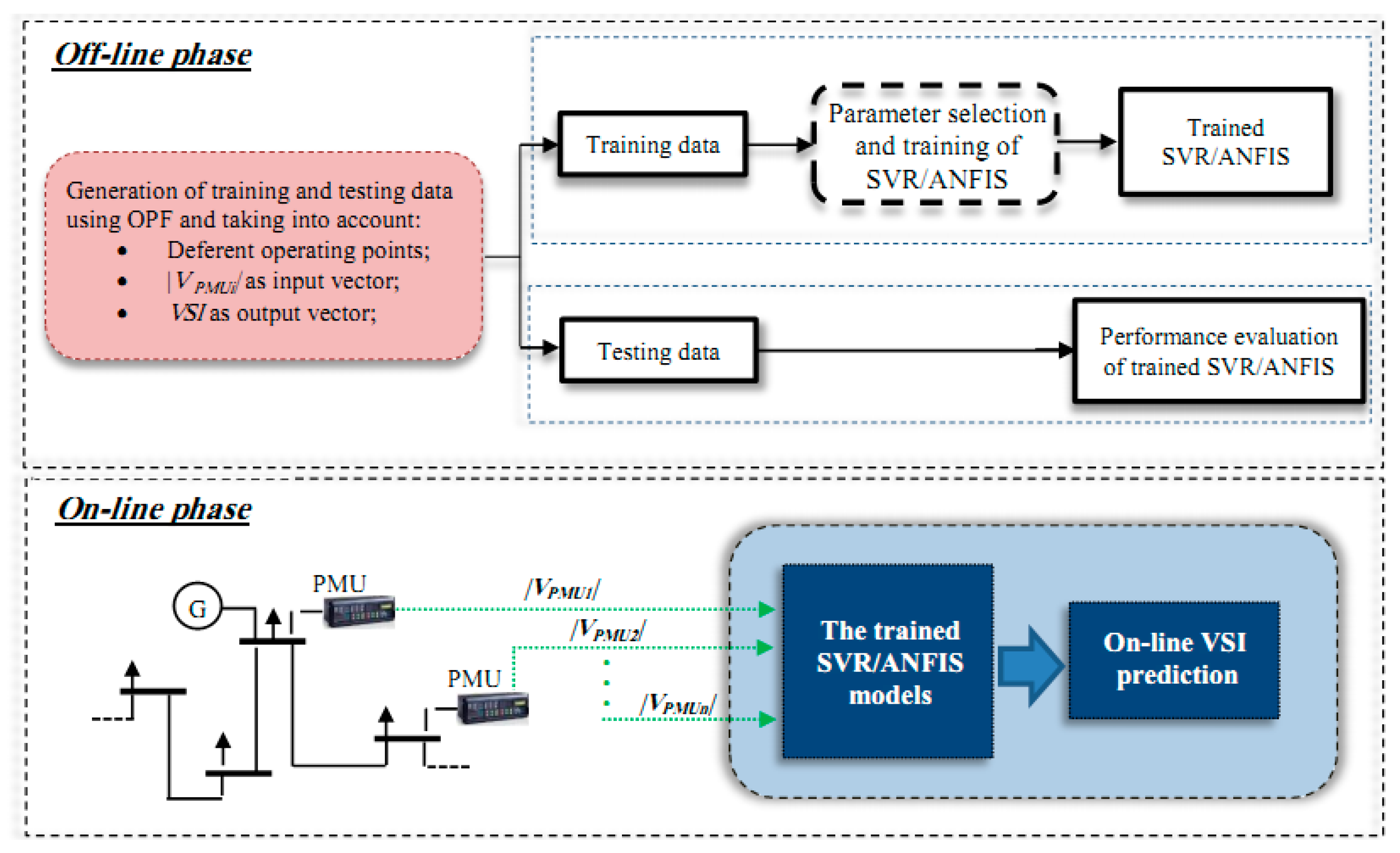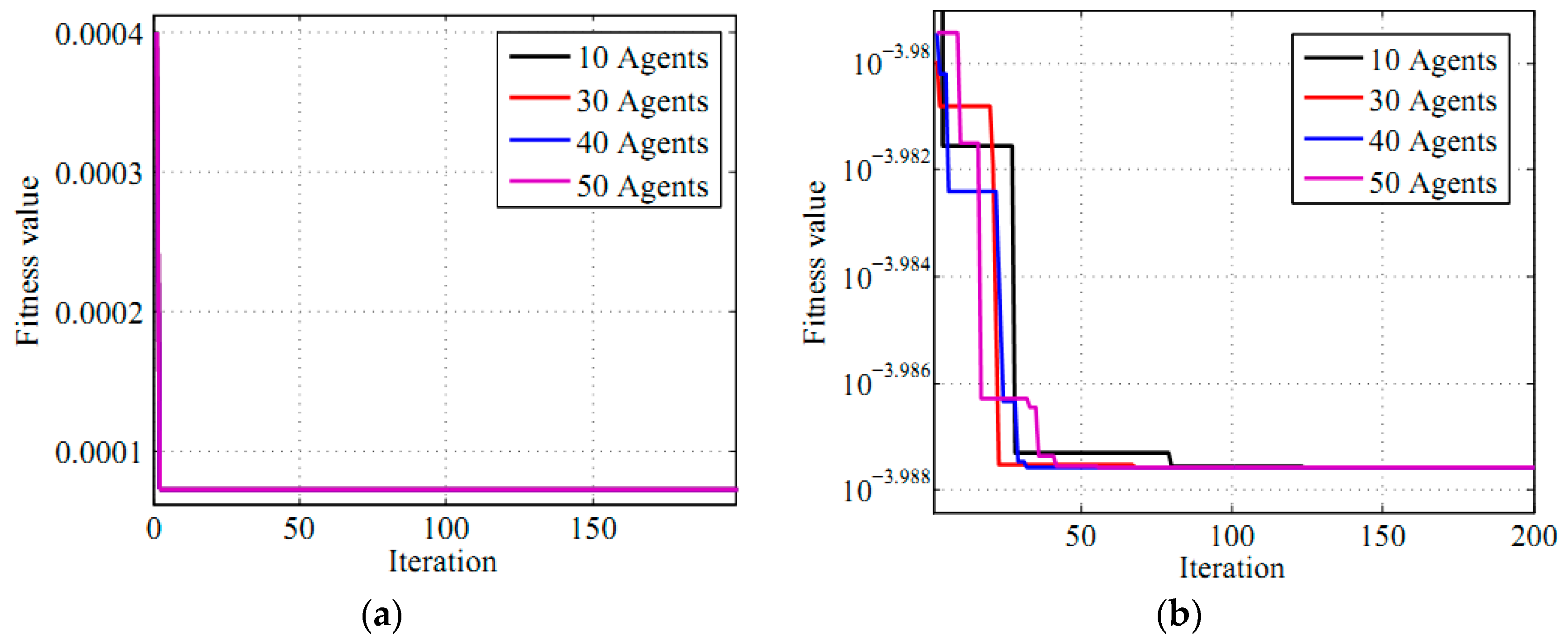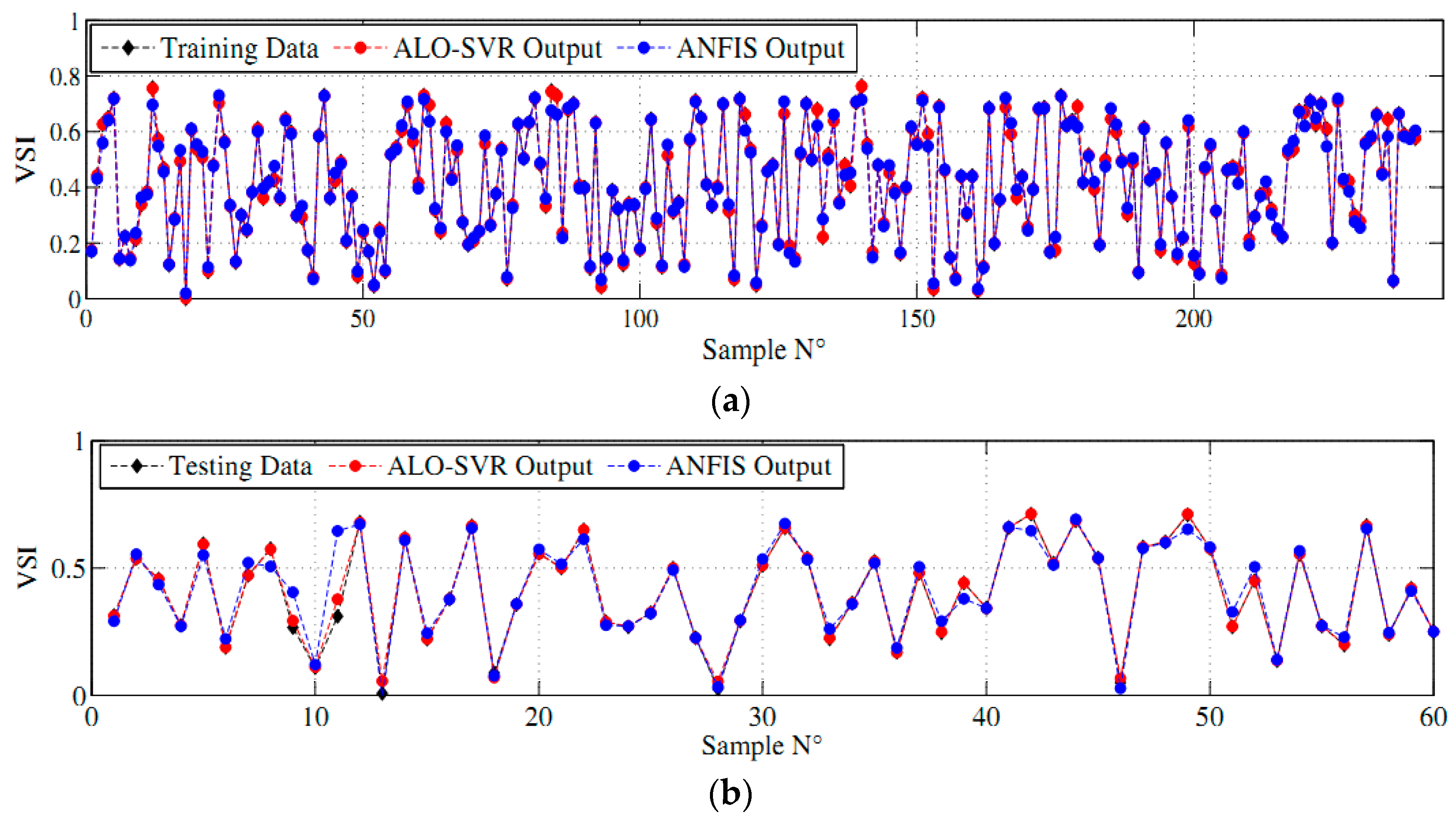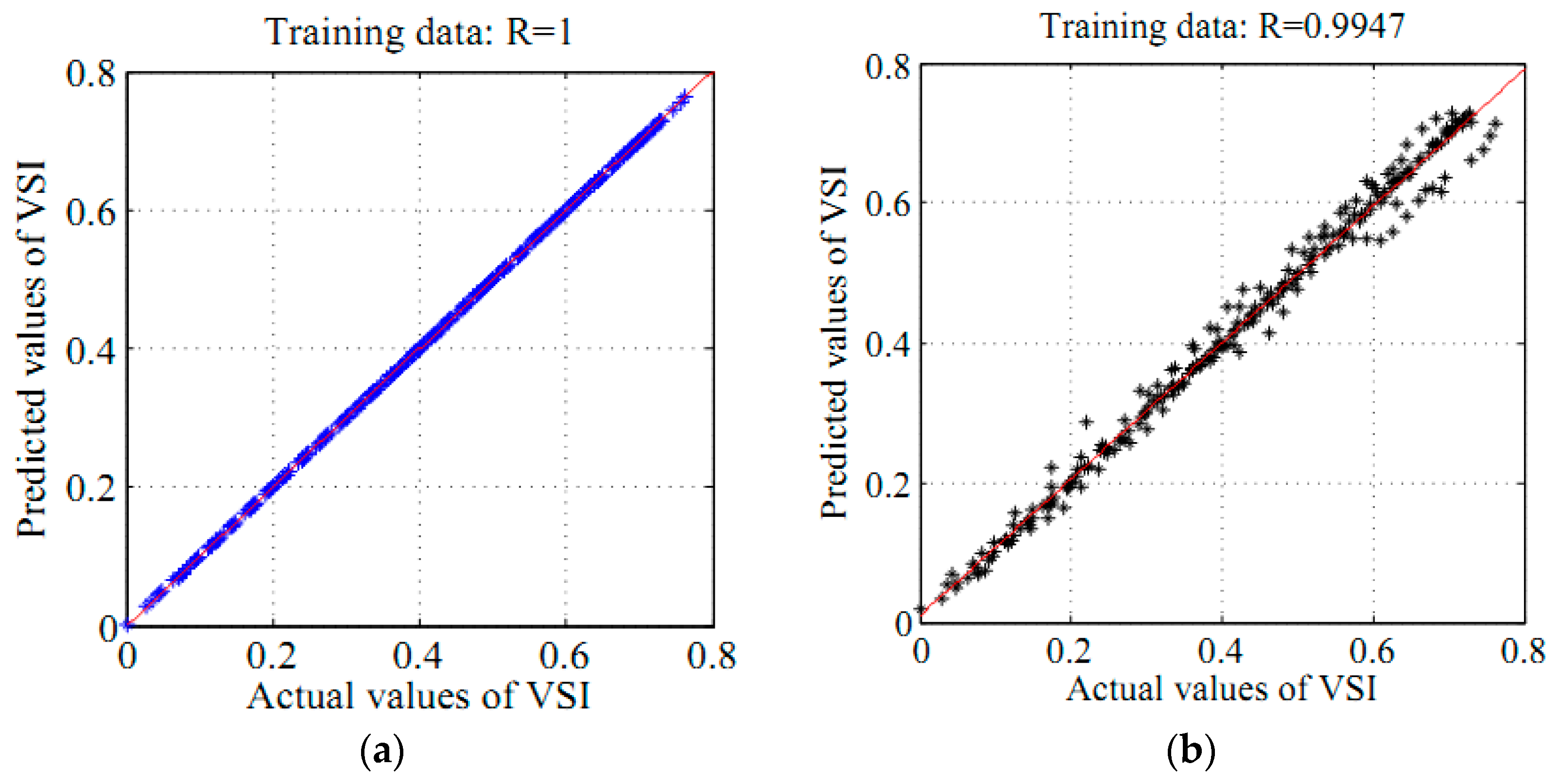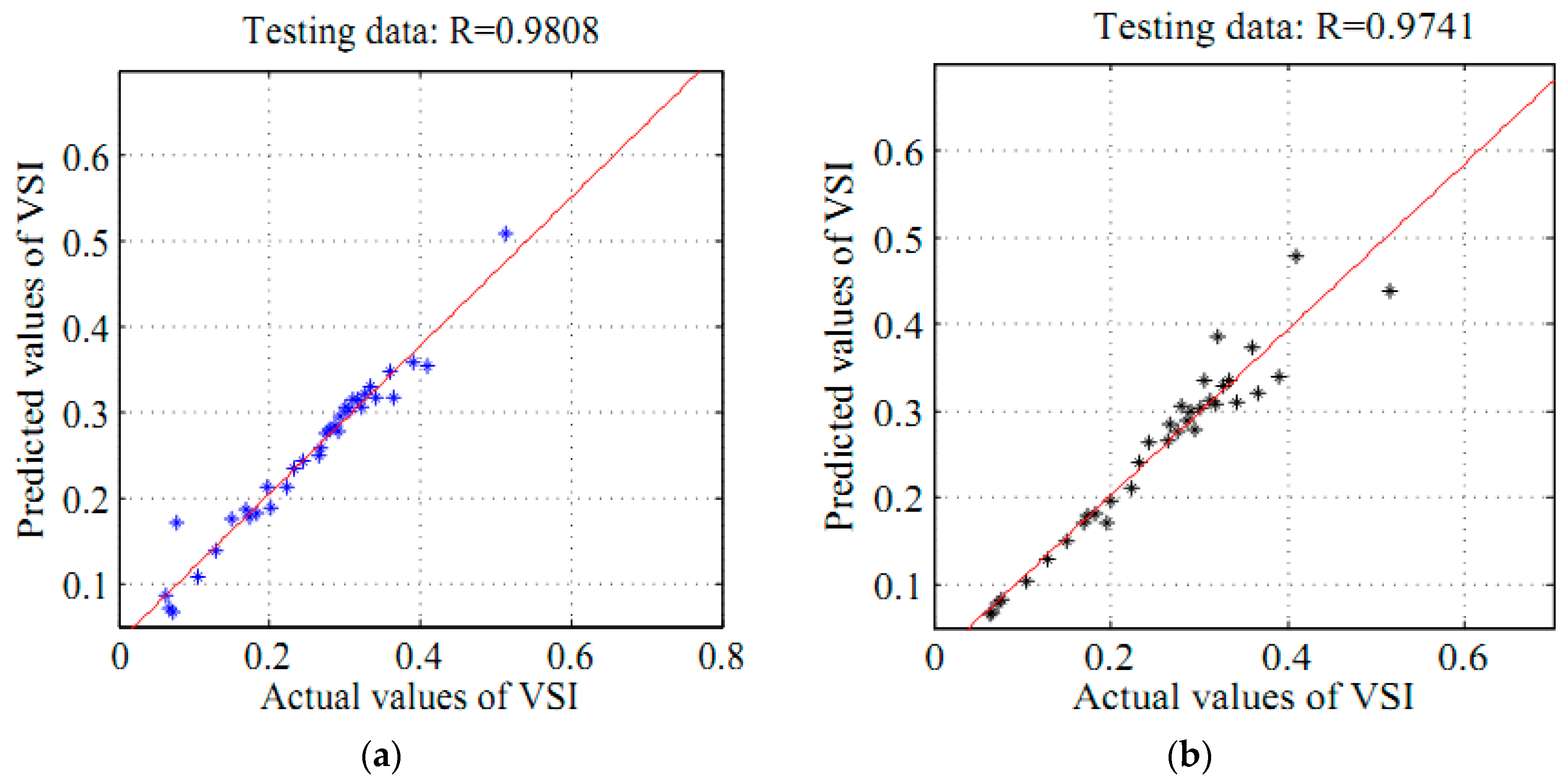1. Introduction
In recent years, the voltage instability problem has become an imperative research area in the field of power system due to the advent of competitive electricity market inflicting towards an intense and complex planning that shove the system to operate near to their stability limits [
1]. In such situations, and for better operation of the system, the voltage stability margins (VSM) and control actions must be determined in an on-line manner. Hence, it is indispensable that the measurement, the estimation, and the analysis be attained during a short period of time. Traditionally, the voltage phasors i.e., voltage magnitudes and angles at all system buses are provided by supervisory control and data acquisition (SCADA) typically every few minutes [
2]. Nowadays, phasor measurement unit (PMU) is employed in many countries to enhance the security, reliability, and the efficient monitoring of the power system [
3]. When compared to the slow nature of SCADA, PMU devices are able to provide the synchronized measurement data (voltages and currents), with great accuracy and 100 times faster than SCADA system [
2]. However, due to the high cost of the PMU devices, it is neither economical nor possible to install these units on the entire power system buses [
4]. On the other hand, the numerous tools that have been developed and introduced by the researchers to conduct a comprehensive analysis on the voltage stability assessment, such as P–V and Q–V curves, continuation power flow and voltage stability indices [
5,
6,
7] have the scarcity to be used in a real-time or on-line operation, as they are computationally time-consuming due to its reliant on a complex mathematical modeling of a power system.
The aforementioned impediments of PMUs installation costs and enormous computational requirements of the traditional methods of voltage stability analysis could be resolved by utilizing the advanced biological computation of artificial intelligence (AI) techniques, such as the artificial neural network (ANN), adaptive neuro-fuzzy inference system (ANFIS), and support vector machines (SVM).
Several ANN architectures have been implemented in on-line voltage stability assessment. Debbie et al. [
8] presented an ANN-based method for on-line assessment of the voltage stability. Chakrabarti [
9] proposed a new methodology for on-line voltage stability monitoring using multi-layered perceptron neural network and a regression-based method of selecting features for training the network. Jayasankar et al. [
10] used a single ANN trained by the back-propagation algorithm to evaluate the voltage stability of power system incorporating flexible AC transmission system (FACTS) devices. Further improvement of ANN performance in an on-line monitoring of voltage stability has been realized by reducing the input data into an optimal size using
Z-score based algorithm [
11]. It is worthwhile to notify that the load active and reactive powers are generally used as the input features for the ANN [
12]. The application of ANN-based radial basis function (RBF) for on-line voltage stability assessment has been performed by several researchers [
13,
14,
15,
16]. The application of self-organizing Kohonen-neural network (KNN) for fast indication and visualization of voltage stability has been conferred [
17]. Chakraborty et al. [
18] incorporated a self-organizing feature map (SOFM) with RBF network for detection and classification of power system voltage instability. Duraipandy et al. [
19] proposed the use of extreme learning machine (ELM) technique for on-line voltage stability assessment with multiple contingencies. Albeit, the ANN has gained considerable attention from researchers in lately as a tool for on-line voltage stability assessment, it has several limitations particularly with respect to a relatively long time required for the training process as well as the problem of sticking at local minima [
20].
Other techniques such as decision tree (DT) and multilinear regression models (MLRM) have been also applied to assess power system voltage stability [
21,
22,
23,
24]. Zheng et al. [
21] proposed the use of DT for fast and accurate evaluation of voltage stability based on PMUs data. Li and Wu [
22] employed the gathered voltage phase angles from PMUs to enhance DT’s identification precision. In [
23], a novel on-line voltage security assessment technique based on wide-area measurements, adaptive boosting technique, and DT algorithm has been developed. Bruno and Venkataramana [
24] proposed a new methodology to estimate the VSM of power system using statistical MLRM and reactive power reserves.
In the last decade, the use of ANFIS and SVR models has attracted much attention to the researchers since these techniques have several advantages and have been successfully applied in different engineering areas. The ANFIS model is a well-developed fuzzy inference system that takes into account the important elements of fuzzy logic and neural network. The prelude utilization of ANFIS has been explored to perform a comprehensive risk assessment of voltage collapse [
20]. The model is constructed in conjunction with the input information of voltage stability indices termed as the VOltage STAbility (VOSTA), while the output was the megawatt (MW) distance of the current operating point from the stability limit demarcated for voltage collapse analysis. Torres et al. [
25], uses the subtractive clustering (SC) and ANFIS methods to estimate the loadability margin by means of various voltage stability indices that have been chosen as the inputs. More recently, the Kohonen-self-organizing map is employed to cluster the real and reactive loads to reduce the input features of ANFIS to compute the loadability margin of a power system incorporating FACTS devices [
26].
Recently, the voltage instability condition of power system has been assessed by imposing SVM [
27], which is a powerful machine learning technique that based on statistical learning theory. However, its application in voltage stability assessment is still in a small volume. Nevertheless, SVM has become a very interesting topic due to its successful application towards classification and regression tasks in other fields of research [
28]. Cortés et al. [
29] successfully employed every single SVM that was trained to classify the state of a system either it is secure, alert, or emergency. The final classification representing a system security assessment is obtained from the combination of each classifier output undertaken by using the Bayesian rule. This approach has been implemented that is relatively similar to the proposed multi-class SVM used for security assessment that has been discussed in [
30]. In the proposed approach, there are four different statuses of system security: normal, alert, emergency_1, and emergency_2 for system splitting statuses that have been used to classify the system security. Further improvement of multi-class SVM has been undertaken by consolidating the pattern recognition approach for security assessment [
31]. Support vector regression (SVR) is an extended version of SVM that has been used to predict the VSM of a power system incorporating flexible AC transmission system (FACTS) devices [
32]. On the overleaf, a new methodology for on-line prediction of VSM has been introduced by deploying the SVR trained by taking into account the input information of real and reactive power load at all of the buses [
28].
Notwithstanding that SVR is an efficient method to solve the nonlinear regression problems, there are no general guidelines to define their parameters, which becomes an impediment to the breadth of the use of SVR in manufacturing applications and scientific research. Inappropriate chosen values of SVR parameters lead to over-fitting or under-fitting problems, and various parameter settings can also lead to considerable differences in performance [
33]. Traditionally, experience-based trial and error [
34], grid search algorithm [
35], and gradient descent algorithm [
36] are the most applied techniques to select the SVR parameters. Convergence to local minima point, computational complexity, and height computational time requirement are the major drawbacks of these conventional methods [
37]. With the development of meta-heuristic optimization algorithms, some of them have been adopted to determine the SVR parameters, such as genetic algorithm (GA) [
38] and particle swarm optimization (PSO) [
39]. However, the performance of these methods is imperfect, the GA encloses a sequence of processes, i.e., coding, selection, crossover, and mutation, which could affect the speed and the precision of this optimization technique. In the same way, the effectiveness of the PSO is influenced by the particle’s multiple parameters [
40].
This paper presents the application of SVR and ANFIS in predicting the VSM with regards to the input data of voltage magnitudes attained from PMUs. As the prediction capability of SVR model tremendously depends on the good selection of its parameters, the recently developed ant lion optimization (ALO) algorithm was employed to determine the optimal parameters of SVR model. Thereafter, the developed ALO-SVR model has been applied to assess the voltage stability and was compared to the ANFIS model. The effectiveness of the proposed approach is verified using the IEEE 30-bus and 118-bus test systems.
2. Voltage Stability Assessment
It is perspicuous that a power system operating at the pinnacle of the unstable condition is conspicuously referring to the voltage magnitude approaching to its limit and it is presented by the voltage stability indices. Many voltage stability indices have been used to evaluate the voltage instability condition [
7,
41,
42,
43]. In this work, the voltage stability index (VSI) is taken as an indicator of voltage stability. The major advantage of this index is that the mathematical formulation is derived considering all of the system margins including active, reactive, and apparent power margins [
44]. The derivation of VSI formulation is originated from a 2-bus system, where the active (P
r) and reactive (Q
r) powers at the receiving bus can be given by Equations (1) and (2), respectively., The voltage at V
r, resulted from combining these equations with eliminating δ, can be expressed by Equation (3).
where V
s and V
r are the voltages at the sending and receiving buses, respectively; R and X are the line resistance and the line reactance, respectively.
The maximum transferable power, S
max, through the line is attained as the internal root phrase equals to zero [
43]. There is only one solution for V
s and V
r is at the collapse point.
The maximum transferred active power P
max, the maximum transferred reactive power Q
max and the maximum transferred power S
max can be expressed by Equations (4)–(6), respectively:
where θ is the load power angle,
.
These Equations can be simplified by assuming high X to R ratio.
Therefore, according to these relations, the total on-line VSI can be calculated as [
44]:
A small value of VSI indicates that the voltage magnitude at the load bus is close to its collapse point. Once the voltage magnitude at a load bus has reached its collapse point, and consequently the VSI is equal to zero and vice-versa.
5. Results and Discussion
In order to investigate the performance of the proposed SVR and ANFIS models used as tools of prediction, the accuracy of predicted VSI will be analyzed for the case studies of IEEE 30-bus and IEEE 118-bus test systems. The important parameter values of these systems are given in
Table 1 and the other detailed parameters can be retrieved from [
53].
In the on-line assessment of voltage stability, the optimal number, and placement of phasor measurement technology based PMUs should be implemented beforehand in such a way that pervasive as well as a coherent observation on the network performance could be rendered with a minimum cost of investment and implementation. In order to obtain the optimal number and locations of PMUs with the aim of static state estimation, the systems were simulated in Power System Analysis Toolbox (PSAT) software version 2.1.5 [
53]. The optimal number and locations of PMUs for both test systems are shown in
Table 2. On the other hand, to identify the most critical contingencies, contingency analysis was carried out for all single line outages in both systems. The selected contingencies, for both test systems, along with their corresponding VSI in the base loading condition, are shown in
Table 3.
The acquired outcomes i.e., the voltage magnitudes and phase angles measured from the PMUs will be used as the input information for the SVR and ANFIS models to estimate the on-line VSI.
5.1. Implementation of ALO-SVR and ANFIS Models in VSI Prediction
This sub-section will divulge on the performance of ALO-SVR and ANFIS models that are used to estimate the VSI of an IEEE 30-bus and IEEE 118-bus test systems. The models were trained and tested using the voltage magnitudes that were taken as the input variables procured from the PMUs right after the load flow solution is performed and the output variable for the models will be the prediction of minimum VSI. The training and testing data sets for both models are generated for the different loading conditions and critical contingencies. The subsequent step involved in the training and testing of ALO-SVR and ANFIS models is to identify the best structure and characteristics that will improve the performance of both models in prediction.
With respect to the development of optimal SVR structure, there are two main steps involved via the selection of kernel function and optimization of the values of penalty (C), ε and kernel parameters. In this research, the Gaussian RBF is used as the kernel function. The performance of the SVR based Gaussian RBF kernel is highly dependent on the RBF kernel width (γ). Unfortunately, there are no defined rules for determining the optimum values of C, ε, and γ since these values should be determined in accordance with the current situation of implementation. As aforementioned, the ALO algorithm seeks for the optimal values of C, γ, and ε parameters.
When using the ALO algorithm for identifying the optimal SVR parameters, some parameters must be determined, such as the maximum number of iterations, the number of search agents (candidate solutions), the fitness function, the number of variables, and the upper/lower bounds of variables. In the present study, the number of iterations was set to 200 with a various number of search agents (10, 30, 40, and 50) to evaluate the impact of these parameters on SVR performance. The RMSE was considered as a fitness function in the optimization process. Moreover, the stopping criterion in this study is the set number of maximum iteration. The ranges of C, γ, and ε parameters are as follows: [1 1000], [0.0001 0.1], and [0.1 1], respectively. The iterative RMSE trend of the ALO searching of the SVR optimal parameters in the training stage is displayed in
Figure 2a,b. It can be seen from this figure that the ALO algorithms based 10, 30, 40, and 50 search agents can all achieve the best fitness values, which are 3.2718 × 10
−4 and 1.0290 × 10
−4 in the cases of IEEE 30-bus and IEEE 118-bus, respectively. However, there is a small difference among them in the convergence speed. The optimal found values of C, γ and ε parameters for both systems are shown in
Table 4.
The subsequent implementation of SVR will be the subtractive clustering method that used to construct the ANFIS model for predicting the VSI. In order to generate fuzzy rules by using the subtractive clustering method, it is essential to determine a proper cluster radius (radii). According to [
54], the recommended values for ‘radii’ should be in the range between 0.2 and 0.5. The RMSE results for different values of cluster radius in testing process are presented in
Table 5. Based on the obtained results, a cluster radius of 0.2 and 0.4 are selected for the case studies of IEEE 30-bus system and IEEE 118-bus system, respectively, for the reason that these values are corresponding to the minimum RMSE.
Once the optimal parameters of SVR and ANFIS models are obtained, the ability of both models in prediction of voltage stability margin was evaluated. In
Figure 3 and
Figure 4, the conventional load flow solution inflicting to the actual values of VSI is compared with the predicted values of VSI determined by using the training and testing processes of ANFIS and ALO-SVR models.
Figure 3a,b, evince that the ALO-SVR provide the results that are in good agreement with the actual values in contrast with the ANFIS and this is referring to the case study of IEEE 30-bus system. The abovementioned discussion is similar with compendium, representing the outcome of ALO-SVR model for the cases study of IEEE 118-bus system as shown in
Figure 4a,b. The linear fits between the actual and results predicted by the ANFIS and ALO-SVR models for the case of IEEE 30-bus system are illustrated in
Figure 5 and
Figure 6. It is obvious that the ALO-SVR model has a good prediction performance in both training and testing processes giving to the linear fits with the correlation coefficient (R) close to 1 when compared to the ANFIS model. This finding is supported by comparing the correlation coefficients (R) of 1 and 0.9947 obtained from the ALO-SVR and ANFIS training processes, respectively. Withal the findings are also supported based on the comparison between the correlation coefficients (R) of 0.9984 and 0.9613 determined corresponding to the output of SVR and ANFIS testing processes, respectively. Hence, the comparison revealed that the ALO-SVR performs a better prediction than the ANFIS either during the training or testing processes. Robustness of the SVR used to predict the VSI compared to the ANFIS for the IEEE 118-bus system is also shown in
Figure 7 and
Figure 8. The finding is proven particularly referring to the R of 1 and 0.9793 for the ALO-SVR and ANFIS training processes, respectively. Similarly, the ensuing particular also corroborates the findings such that the R of 0.9807 and 0.9741 for the ALO-SVR and ANFIS testing processes, respectively. These values show that the ALO-SVR prediction is better than the ANFIS prediction.
In order to further assess the performance of ALO-SVR model to discern with the ANFIS model, the performance indicator predicated by the root mean square error will be used in the comparative analysis. The model’s performance towards training and testing processes for the case studies of IEEE 30-bus and IEEE 118-bus systems is expounded in
Table 6. The statistical error obtained from training process indicated that the ALO-SVR model produced relatively lower RMSE of 3.2718 × 10
–4 for the case study of IEEE 30-bus and 1.0290 × 10
–4 for the case study of IEEE 118-bus than the results provided using the ANFIS model which is 0.0209 for the case of IEEE 30-bus and 0.0238 for the case of IEEE 118-bus. For the testing process, the RMSE values of 0.0118 and 0.0535 are obtained by the ALO-SVR and ANFIS models for the case study of IEEE 30-bus system, respectively. For the case study of IEEE 118-bus system, the predictions are resulting to the RMSE of 0.0230 for ALO-SVR testing process and RMSE of 0.0238 for ANFIS testing process. From the obtained results, it is clear that the ALO-SVR model acquired relatively smaller RMSE and larger R contradictory with the ANFIS model during both training and testing processes. In other words, the ALO-SVR performance culminates in giving the best prediction results than the ANFIS model.
Table 6 shows the results of the comparative study between the ALO-SVR and ANFIS models for both test systems.
5.2. Impact of PMUs Outage on ALO-SVR Performance
The effectiveness of the proposed ALO-SVR model in the estimation of VSI was also checked in the case of PMUs loss contingency.
Table 7 lists the performance indices of three test scenarios with PMUs outage for both test systems. These scenarios include the outages of one, two, and three PMUs in both case studies of IEEE 30-bus and IEEE 118-bus test systems. From the
Table 7, it can be seen that the proposed ALO-SVR model is still able to accurately predict the VSI when PMUs outage is considered.
